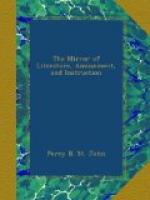eyebrow, which is the language of passion rather than
poetry, I had not for ten years indulged the wish
to couple so much as
love and
dove, when
finding Lewis in possession of so much reputation,
and, conceiving that, if I fell behind him in poetical
powers, I considerably exceeded him in general information,
I suddenly took it into my head to attempt the style
by which he had raised himself to fame.”
Sir Walter next hearing a striking passage from Mr.
W. Taylor’s translation of Buerger’s
Leonore,
was induced to procure a copy of the original poem
from Germany, and “the book had only been a
few hours in my possession, when I found myself giving
an animated account of the poem to a friend, and rashly
added a promise to furnish a copy in English ballad
verse. I well recollect that I began my task after
supper, and finished it about daybreak the next morning,
(it consists of 66 stanzas,) by which time the ideas
which the task had a tendency to summon up, were rather
of an uncomfortable character.” This success
encouraged Sir Walter to publish his translation of
Leonore with that of
Der Wilde Jager
(the Wild Huntsman,) in a thin quarto; but, other
translations appearing at the same time, Sir Walter’s
adventure proved a dead loss: “and a great
part of the edition was condemned to the service of
the trunk-maker.” This failure did not discourage
Sir Walter; for, early in 1799 he published
Goetz
of Berlinchingen, a tragedy, from the German of
Goethe. We thus see that Sir Walter did not conceal
his obligation to Lewis, for his aid in his translations;
but Lord Byron’s assertion that Monk Lewis corrected
Scott’s verse, and that he understood little
then of the mechanical part of it—is far
from true, as a comparison of their productions warrants
us to conclude.
Sir Walter’s first attempt at originality was
in ballad poetry. He says:—“The
ballad called Glenfinlas was, I think, the first
original poem which I ventured to compose. After
Glenfinlas, I undertook another ballad, called
The Eve of St. John. The incidents, except
the hints alluded to in the notes, are entirely imaginary;
but the scene was that of my early childhood.
Some idle persons had of late years during the proprietor’s
absence, torn down the iron-grated door of Smailholm
Tower from its hinges, and thrown it down the rock.”
Sir Walter prevailed on the proprietor to repair the
mischief, on condition that the young poet should
write a ballad, of which the scene should lie at Smailholm
Tower, and among the crags where it is situated.
The ballad, as well as Glenfinlas, was approved
of, and procured Sir Walter many marks of attention
and kindness from Duke John of Roxburgh, who gave
him the unlimited use of the Roxburgh club library.
MINSTRELSY OF THE SCOTTISH BORDER.




